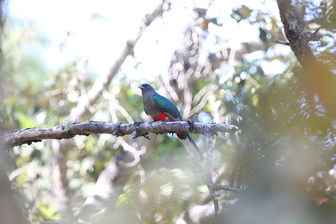Eared trogon
It is a resident of the middle to upper levels of pine-oak woodlands and oak-conifer forests, frequently along streams. It nests 5–9 m high in an unlined shallow tree cavity, usually selecting an old woodpecker hole. Nests have been observed in pine, fir, maple, and aspen trees. Limited excavation of the cavity is accomplished using the bill to dig into the rotten wood of the walls and opening.

Original source: Dominic SheronyPermission(Reusing this file)This image, which was originally posted to Flickr.com, was uploaded to Commons using Flickr upload bot on 03:06, 1 November 2011 (UTC) by Rufous-crowned Sparrow (talk). On that date it was licensed under the license below. This file is licensed under the Creative Commons Attribution-Share Alike 2.0 Generic license.You are free:to share – to copy, distribute and transmit the work
Author: Dominic SheronyPermission(Reusing this file)This image, which was originally posted to Flickr.com, was uploaded to Commons using Flickr upload bot on 03:06, 1 November 2011 (UTC) by Rufous-crowned Sparrow (talk). On that date it was licensed under the license below. This file is licensed under the Creative Commons Attribution-Share Alike 2.0 Generic license.You are free:to share – to copy, distribute and transmit the work
The Eared trogon is classified as Near Threatened (NT), is close to qualifying for or is likely to qualify for a threatened category in the near future.
The Eared Trogon in Arizona: Behavior, ecology, and management of the "Northern Quetzal." Pages 98–101 in Proceedings of the Chiricahua Mountains Research Symposium, 15-16 March 1992. Southwest Parks and Monuments Association, Tucson, Arizona. More
* In many years an Eared Trogon or two will be seen in the mountains of southeastern Arizona. * When Eared Trogons are seen it is usually in late summer or fall. * Eared Trogons are usually seen farther up in the canyons than most birders tend to hike. They like the pine trees of the higher elevations. * The first U.S. record of Eared Trogon was in October, 1977. More
Eared Quetzal (recently renamed from Eared Trogon) is an extremely rare bird in the US, with only a handful of records from southern AZ. This bird was even farther north at a location along the Mogollon Rim northeast of Payson. A non birder reported a possible trogon out of range and out of season, so it was a real treat to actually find that the report was valid. The photo was taken in the middle of a wooded area when the bird unexpected landed about 15 feet overhead. More
EARED TROGONS NEST IN RAMSEY CANYON by Sheri Williamson originally published in Trogon News, December 1991 reprinted in slightly edited form as "First nesting of Eared Trogon in the United States" in Winging It!, July 1992 The long-awaited discovery of an Eared Trogon nest in the United States occurred in autumn in the Huachucas, not in summer in the Chiricahuas as had been predicted. More
Formerly known as Eared Trogon, the Eared Quetzal is the northernmost of six species of quetzals. It is endemic to western Mexico, resident from Michoacan northward to Sonora and Chihuahua, rarely to southeastern and central Arizona. Like other quetzals but unlike the more common Elegant and Mountain trogons, the adult male Eared Quetzal (left and below) has no white band separating the emerald green breast from the rose red belly. The hair-like ear tufts that give the species its name are seldom visible. More
THE EARED TROGON IN ARIZONA: BEHAVIOR, ECOLOGY, AND MANAGEMENT OF THE "NORTHERN QUETZAL" Sheri L. Williamson The Nature Conservancy, Ramsey Canyon Preserve 27 Ramsey Canyon Road Hereford, AZ 85615 Current address: Southeastern Arizona Bird Observatory P.O. Box 5521 Bisbee, AZ 85603-5521 sheri@sabo. More
Although Eared Trogon is still officially considered accidental in Arizona, and although anyone coming to Arizona to look for one not already staked out would be considered not to have a life, this should not preclude Euptilotis neoxenus from the list of Arizona's special species-species found only here or more easily here than in any other state. More
Eared Trogon ( Euptilotis neoxenus) American Ornithologists' Union 6th edition (incl. 35th suppl.): Eared Trogon ( Euptilotis neoxenus) American Ornithologists' Union 6th edition (incl. 36th suppl.): Eared Trogon ( Euptilotis neoxenus) American Ornithologists' Union 6th edition (incl. 37th suppl.): Eared Trogon ( Euptilotis neoxenus) American Ornithologists' Union 6th edition (incl. 38th suppl.): Eared Trogon ( Euptilotis neoxenus) American Ornithologists' Union 6th edition (incl. 39th suppl. More
Eared Trogon Euptilotis neaxenus Baird's Trogon Trogon bairdii Have You Seen The Other Earthlife Web Chapters The Home Page of the Fish The Birds Home Page The Insects Home Page The Mammals Home Page The Prokaryotes Home Page The Lichens Home Page - - Index Gif More
Distribution, habitat and status of the Eared Trogon Euptilotis neoxenus Notes on some other birds and mammals Priority areas for conservation in the Sierra Madre Occidental References appendix 1: Thick-billed Parrot observations appendix 2: Eared Trogon observations appendix 3: Observations of Tufted Jay, Spotted Owl and Golden Eagle appendix 4: Birds observed at 12 locations in the Sierra Madre Occidental appendix 5: Ground truthing of old-growth areas predicted by analysis More
Mexico - the Eared Trogon Euptilotis neoxenus - is a real prize. Not only is it lovely and rare, but it has loud, raucous, memorably and totally un-trogon-like calls. The most spectacular of the Trogon family are the five species of quetzal (genus Pharomachrus), and the most famous is the Resplendent Quetzal (below; both shots) of Central America. The male has one of the longest tails (actually modified uppertail coverts) in the world. More
Family : Trogonidae
Genus : Euptilotis
Species : neoxenus
Authority : (Gould, 1838)

